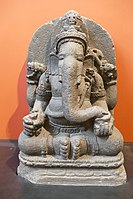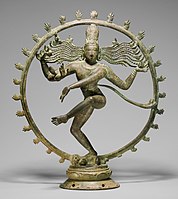Chaturbhuja

Chaturbhuja (Sanskrit: चतुर्भुज, romanized: Caturbhuja, lit. 'four-armed') is a concept in Hindu iconography in which a deity is depicted with four arms. Several Hindu deities are often portrayed with four arms in their iconography, featured in Hindu literature. The iconography of four arms is regarded to symbolise divinity and power, as well as dominion over the four quarters of the universe.[1]
Chaturbhuja is also primarily employed as an epithet for the preserver deity, Vishnu.[2][3]
Description
The earliest Vaishnava images, according to scholar Gavin Flood, are of a standing two or four-armed figure bearing a combination of the attributes of a conch, a wheel, and a mace in their iconography. This multiplicity convention, in which deities bore numerous limbs and heads in their imagery, was established in the Mathura region, before becoming a custom in later Hindu iconography.[4]
According to author Nanditha Krishna, the chaturbhuja representation of Hindu deities in their icons is regarded to depict their unlimited potential. It exhibits their divine ability to wield multiple articles, such as weapons, and perform numerous activities simultaneously.[5]
Indologist Doris Srinivasan states that in both Vaishnava and Shaiva imagery, the Chaturbhuja form is regarded to be the manifestation of a deity who descends upon the earth and performs auspicious acts for the well-being of mankind, typically receiving the veneration of human beings.[6]
Examples
Vishnu is generally depicted with four arms, carrying his four attributes of the Panchajanya (conch), Sudarshana Chakra (discus), Kaumodaki (mace), and Padma (lotus).[7] His ten incarnations are also often depicted in their icons with these four attributes, most prominently in his avatar of Krishna.[8][9]
Lakshmi carries lotuses in two of her hands, the other two expressing the gestures of the abhaya mudra and the varada mudra, sometimes replaced by a kalasha and a mirror.[10]
Shiva is depicted with four hands in his form of Nataraja. His back right hand holds a damaru (drum), his front right hand expresses the abhaya mudra, the back left hand carries fire upon a vessel or the palm of his hand, and his front left hand expresses the gajahasta mudra.[11][12] This allegorical depiction of his multiple arms is regarded to indicate his functions of creation and destruction.[13]
Parvati is described as four-handed, holding a noose and a goad, and the other two hands portraying the abhaya mudra and the varada mudra in the Shiva Purana.[14]
Ardhanarishvara, a composite form, holds a trishula (trident) and expresses the varada mudra on the right half, representing Shiva, while the left half holds a lotus, representing Parvati.[15]
Harihara, a composite form, holds a trishula and skull-cap in his two right hands, representing Shiva, and a conch and a discus in his two left hands, representing Vishnu.[16]
Brahma is depicted to be holding the Vedas and a rosary in his four hands.[17]
Saraswati is portrayed as holding the instrument known as the veena with two of her hands, and an assortment of a book, a noose, a rosary, an elephant goad, and a lotus in her other two hands.[18]
Ganesha bears a noose, an elephant goad, a sweet dumpling called the modaka, and his other hand portrays the abhaya mudra.[19]
Indra is portrayed with a spear, a goad, the Vajra, and a blue lotus.[20]
Agni is featured with four hands in the Harivamsha.[21]
Tripura Sundari is described with four hands in the Kalika Purana.[22]
Gallery
References
- ^ Stutley, Margaret (2019-04-09). The Illustrated Dictionary of Hindu Iconography. Routledge. p. 107. ISBN 978-0-429-62425-4.
- ^ Rama, Swami (1985). Perennial Psychology of the Bhagavad Gita. Himalayan Institute Press. p. 469. ISBN 978-0-89389-090-2.
- ^ Dowson, John (2004). A Classical Dictionary of Hindu Mythology, and Religion, Geography, History, and Literature. Asian Educational Services. p. 388. ISBN 978-81-206-1786-5.
- ^ Bailey, Greg (2017-01-02). Hinduism in India: The Early Period. SAGE Publications India. p. 181. ISBN 978-93-5150-573-0.
- ^ Kirshna, Nanditha (2009-07-20). Book of Vishnu. Penguin UK. p. 15. ISBN 978-81-8475-865-8.
- ^ Srinivasan, Doris (1997). Many Heads, Arms, and Eyes: Origin, Meaning, and Form of Multiplicity in Indian Art. BRILL. pp. 157, 168. ISBN 978-90-04-10758-8.
- ^ Berg, Sebastian (2021-11-03). Hindu Mythology: A Guide to the Gods and Goddesses of India. Creek Ridge Publishing. p. 18.
- ^ Bhattacharya, Sunil Kumar (1996). Krishna-cult in Indian Art. M.D. Publications Pvt. Ltd. p. 58. ISBN 978-81-7533-001-6.
- ^ Cush, Denise; Robinson, Catherine; York, Michael (2012-08-21). Encyclopedia of Hinduism. Routledge. p. 181. ISBN 978-1-135-18979-2.
- ^ Coulter, Charles Russell; Turner, Patricia (2013-07-04). Encyclopedia of Ancient Deities. Routledge. p. 650. ISBN 978-1-135-96397-2.
- ^ Hoiberg, Dale (2000). Students' Britannica India. Popular Prakashan. p. 93. ISBN 978-0-85229-760-5.
- ^ Jost, Diana Brenscheidt gen; Brenscheidt, Diana (2011). Shiva Onstage: Uday Shankar's Company of Hindu Dancers and Musicians in Europe and the United States, 1931–38. LIT Verlag Münster. pp. 242–243. ISBN 978-3-643-90108-8.
- ^ Roberts, Helene E. (2013-09-05). Encyclopedia of Comparative Iconography: Themes Depicted in Works of Art. Routledge. p. 171. ISBN 978-1-136-78792-8.
- ^ Shastri, J. L. (2017-01-01). The Siva Purana Part 4: Ancient Indian Tradition and Mythology Volume 4. Motilal Banarsidass. p. 1661. ISBN 978-81-208-3871-0.
- ^ Dalal, Roshen (2010). Hinduism: An Alphabetical Guide. Penguin Books India. p. 37. ISBN 978-0-14-341421-6.
- ^ Parmeshwaranand, Swami (2004). Encyclopaedia of the Śaivism. Sarup & Sons. p. 290. ISBN 978-81-7625-427-4.
- ^ Chugh, Lalit (2016-04-08). Karnataka's Rich Heritage – Art and Architecture: From Prehistoric Times to the Hoysala Period. Notion Press. p. 186. ISBN 978-93-5206-825-8.
- ^ Chugh, Lalit (2017-05-23). Karnataka's Rich Heritage – Temple Sculptures & Dancing Apsaras: An Amalgam of Hindu Mythology, Natyasastra and Silpasastra. Notion Press. p. 529. ISBN 978-1-947137-36-3.
- ^ Wuthnow, Robert (2011-07-01). America and the Challenges of Religious Diversity. Princeton University Press. p. 42. ISBN 978-1-4008-3724-3.
- ^ Dalal, Roshen (2014-04-18). Hinduism: An Alphabetical Guide. Penguin UK. p. 559. ISBN 978-81-8475-277-9.
- ^ Chandra, Suresh (1998). Encyclopaedia of Hindu Gods and Goddesses. Sarup & Sons. p. 10. ISBN 978-81-7625-039-9.
- ^ Kinsley, David (1988-07-19). Hindu Goddesses: Visions of the Divine Feminine in the Hindu Religious Tradition. University of California Press. p. 147. ISBN 978-0-520-90883-3.





